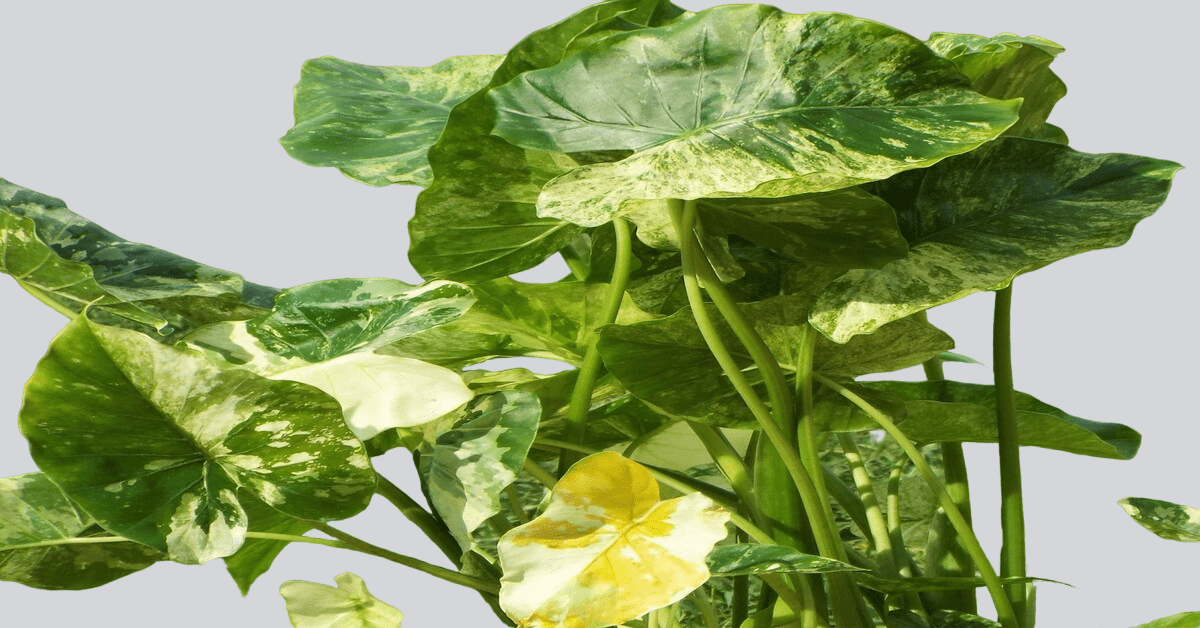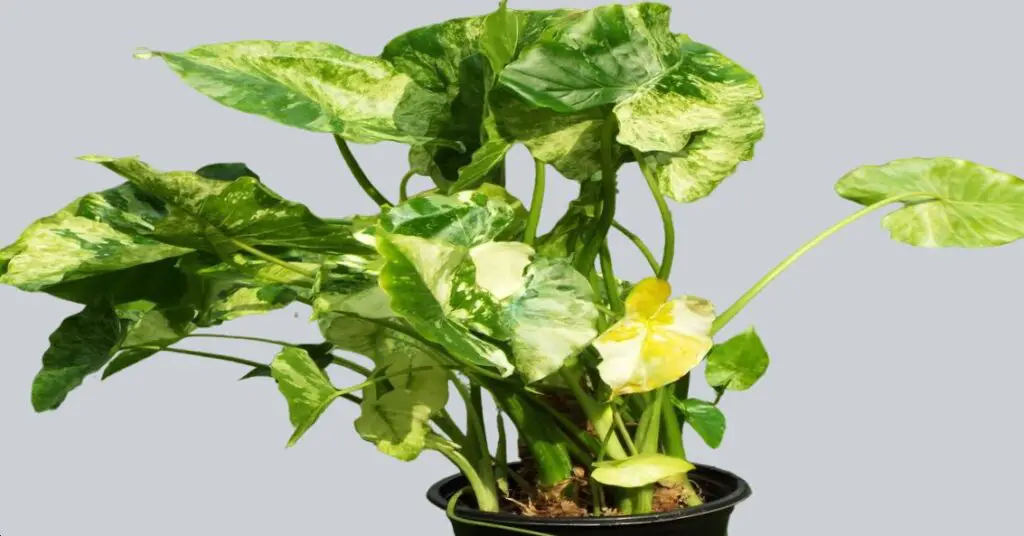Some of the links in this post are affiliate links. This means if you click on the link and purchase the item, I will receive an affiliate commission at no extra cost to you.
Alocasia ‘Dawn’ variegated is a perennial, herbaceous plant in the Arum family (Araceae). It originated from a mutation of the parent plant Alocasia macrorrhiza variegata during cultivation[1]. It has heart-shaped leaves that are green and mottled with white variegations.
Alocasia’s growth rate is slow to moderate. Mature Alocasia ‘Dawn’ size depends on if it is grown in a pot or in the ground. It typically grows 3 to 5 feet tall and 2 to 4 feet wide.
Alocasia Dawn was patented by its creator Dawn Wilson from Nature’s Way Farms (Patent #PP35010)[1]. Therefore, having Alocasia ‘Dawn’ for sale requires permission or a license from the inventor for 20 years. Because it is patented, Alocasia ‘Dawn’ is a rare plant with limited suppliers which increases the Alocasia ‘Dawn’ price.
To purchase an Alocasia Dawn click here
Alocasia Dawn Variegated Care

Alocasia ‘Dawn’ is a low-maintenance plant that is easy to care for. It likes bright, indirect light and soil that is moist but not water logged. As a tropical plant, it also needs some humidity and doesn’t handle cold temperatures well.
This elephant ear variety has very few pest problems when grown under the right conditions. It also doesn’t require any pruning. Below you’ll find all of the details on how to care for Alocasia ‘Dawn’ so it matures into a large, healthy plant.
Soil
Alocasia variegated ‘Dawn’ needs to be grown in well-draining soil that is able to stay moist but not wet. This will ensure that the roots stay happy and healthy as the plant grows.
The inventors of Alocasia ‘Dawn’ recommend using a mixture of pine bark, potting soil, peat moss, and perlite. Mix 5 parts pine bark to 1 part each of potting soil, peat moss, and perlite. This will create a well-draining potting mix that is also able to retain moisture.
Watering
To keep Alocasia ‘Dawn’ variegated thriving, it needs the soil to be moist but not water-logged. Temperature, humidity, and other factors impact how quickly the soil dries. You’ll need to check the soil for moisture to know when watering is needed.
Start with watering it twice a week. Before watering, check the soil to see if it is moist. If you find that the soil is drying out when being watered twice a week, increase watering to three times per week.
Lighting
Alocasia ‘Dawn’ needs plenty of bright, indirect sunlight. It is best to place them near an east-facing window for good lighting conditions. If you need to place it in a south-facing window, use a sheer curtain or blinds to shield it from direct sunlight.
Like most elephant ear plants, Alocasia ‘Dawn’ leaves can be burned by direct, afternoon sunlight. If you place it outside during summer, make sure it gets shade in the afternoon.
Humidity & Temperature
As a tropical plant, Alocasia ‘Dawn’ prefers 60 to 80 percent humidity. If you need to increase the humidity, consider getting a small humidifier and placing it nearby. You can also add a pebble tray with water beneath the pot to increase humidity around the plant.
The ideal temperature range for growing variegated Alocasia ‘Dawn’ is 65 to 80 degrees Fahrenheit. Since most homes stay within this range indoors, the temperature shouldn’t be an issue.
It’s worth noting that temperatures below 60 degrees Fahrenheit will harm your Alocasia ‘Dawn’ plant. In winter, make sure you keep it away from any drafts near doors or windows to prevent damage.
Fertilizing
The creators of Alocasia ‘Dawn’ recommend you fertilize every 6 months to increase their growth. They use an 18-6-8 fertilizer for the plants they grow[1]. That means it has 18 percent nitrogen, 6 percent phosphorus, and 8 percent potassium (NPK).
You can also use a 10-10-10 liquid fertilizer which may be easier to find. You can use this every 6 to 8 weeks during spring and summer and every 2 to 3 months in fall and winter.
Propagation
Since Nature’s Way Farms Alocasia ‘Dawn’ is a patented plant, it isn’t legal to propagate it. The patent makes asexual reproduction of the plant off-limits. The only legal way to reproduce a patented plant is by seed.
When it comes to propagating Alocasia ‘Dawn’ and other elephant ear species, using corms is normally the best method. The parent plant can be dug up to expose the corms, which are similar to bulbs. They can then be separated to create new plants from divisions of the mother plant.
Diseases & Pests
Alocasia ‘Dawn’ has not yet been tested for disease and pest susceptibility or tolerance. It likely has the same disease and pest issues as the parent plant, Alocasia macrorrhiza variegata, it was derived from.
The two most common pests are regular indoor houseplant pests: spider mites and mealybugs. You should check for their signs (yellow to white spots or cottony-looking residue) each time you water your plant. If you notice insect damage or signs, you can get rid of them using neem oil.
Root rot is the most likely disease Alocasia ‘Dawn’ suffers from and is caused by overwatering. They may also be susceptible to bacterial leaf spot which causes yellow blotches on leaves. Make sure you properly water your plant to help prevent disease issues from developing.
Toxicity
Alocasia ‘Dawn’ and all elephant ear plants contain calcium oxalate. Calcium oxalate is toxic when ingested by humans, cats, and dogs. You should keep this plant out of reach of children, cats, and dogs to avoid potential harm.
USDA Zones
The variegated Alocasia ‘Dawn’ is a tropical plant and can only be grown outdoors in areas with very mild winters. While most people will need to grow it only indoors, it can survive outside in USDA Hardiness Zones 9 through 11.
Alocasia Dawn vs Odora Variegata
The main difference between Alocasia ‘Dawn’ and Odora ‘Variegata’ is the shape and size of the sinus of the leaves. The sinus is the area created between the two sides of the leaves where it is attached to the petiole. It’s the area that gives elephant ear leaves their heart shape.
The sinus of Alocasia ‘Dawn’ is much more narrow, creating a slender ‘V’ shape. The sinus of Alocasia Odora ‘Variegata’ is wider and more ‘U’ shaped. Of course, there is some variation among individual plants.
References
[1] Wilson, D. F. (2023). Plant named ‘Dawn’ (U.S. Patent No. PP35010). U.S. Patent and Trademark Office.

